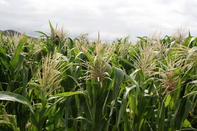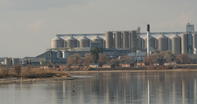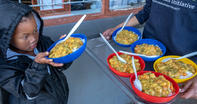Great Tortilla Uprising
South Africa’s staple, maize, has many faces: a bowl of sadza or umphokoqo with beans; lumps of iphuthu, moulded into the hand and dipped into meaty sauce, krummelpap with melted butter, sugar and milk; boiled mealie or braaied sweetcorn. Sometimes, it comes in a glass of umqombothi, with a kick as gentle as an unshod ass.

In Mexico, the very heartland where the giant grass was first domesticated from its wild state, maize as a staple takes the from of tortillas. A novelty to South Africans, perhaps, tortilla is that delicious unleavened bread made from maize flour and water and these days is used to wrap up refried beans, chilli con carne, salsa and guacamole in gimmicky Mexican restaurant franchises the globalised world over.
But while farmers were watching the skies dry up over their Free State maize lands in the summer of 2007, half a world away, Mexico City was taking to the streets in what we shall dub the Great Tortilla Uprising. The demonstrations were to protest a staggering 400 percent increase in the price of tortillas, the BBC reported, the most radical food price hike in decades. This was just one of a series of displays of malcontent around the world in response to over-inflated food prices.
Soaring Prices for Basic Foods

John Vidal, The Guardian’s environmental writer, put it succinctly: “Empty shelves in Caracas. Food riots in West Bengal and Mexico. Warnings of hunger in Jamaica, Nepal, the Philippines and sub-Saharan Africa.
Soaring prices for basic foods are beginning to lead to political instability, with governments being forced to step in to artificially control the cost of bread, maize, rice and dairy products… India, Yemen, Mexico, Burkina Faso and several other countries have had, or been close to, food riots in the past year, something not seen in decades of low global food commodity prices.” The Food and Agriculture Organization of the United Nations (FAO) blamed the global situation on growing demand for food, particularly in China and India, along with extreme regional weather which slashed the harvest (while some parts of southern Africa were crisping over with drought, others regions were awash with flood waters).
Meanwhile volatile oil prices sent petrol and diesel costs skyrocketing – something which always impresses itself on the final shelf price on food items that have to be shipped across tremendous distances between farmer and consumer. But there was one new force in the global food equation, tugging the market towards prices that were so inflated, many poorer Mexicans faced hunger: biofuels.
Petrol Alternative

The United States, trying to buffer itself against the vagaries of an up-again up-again oil price, was filling a portion of the national fuel tank with maize – specifically ethanol, made from fermented sugars in maize as a substitute for petrol.
And the country was buying up vast amounts of the North American maize crop. At face value, biofuels look like the perfect solution to reining in the transport sector’s carbon emissions. Instead of looting ancient banks of fossil fuels, and cycling their carbon up into the atmosphere through the furnace that is the engine of your car, why not use a carbon neutral or low carbon fuel?
Hunger on the Increase

The big issue, as the Mexican tortillas riots demonstrate, is food. Biodiesel and bioethanol are both made from crops which are traditionally used for food. In a world where global hunger is still on the rise, is it smart or even fair to take maize from one person’s dinner plate and, instead, use it to fill another’s petrol tank?
In spite of advances in high-yield seeds, synthetic fertilisers, irrigation, mechanised farming, pest and weed controls, and everything else that goes with the green revolution, it is not enough to keep the world’s ever-growing population well fed.
The United Nations General Assembly estimates that the “number of people suffering from hunger has increased to 854 million people and has been rising every year since 1996. Virtually no progress has been made on reducing hunger… More than 6 million children still die every year from hunger and hunger-related causes before their fifth birthday”.
No Equal Access

But it’s more complicated than that. It’s not that we can’t produce enough food – we can. In fact, enough to feed the entire 6.5 billion population twice over. The problem is that the food which is available to us is not distributed neatly across the world and across the classes like a neatly buttered slice of bread.
On average, we may be richer than ever before, but that doesn’t give everyone equal access to the food. It’s basic free market economics – supply and demand. Greater demand for a product, or a shortage of that product, and the price goes up. When that commodity is food, and the currency is cash, it’s the poor who are the first to go hungry when a food shortage pushed up the price.
If a burgeoning biofuels market begins to absorb a percentage of the maize crop, there’s going to be less available to the food market, but the same demand. Food shortages become high food prices.
Battle Between Food and Fuel

Africa’s food market is particularly vulnerable. For some reason, the green revolution which brought considerable increases in food production elsewhere on the globe have not been realised in Africa. The Food and Agriculture Organization of the United Nations (FAO) calculates that the per-capita food production on the continent has been declining for the past two decades. Even in places where production has increased, it has not kept up with the population growth, according to the FAO.
This leaves around a third of sub-Saharan Africa either malnourished or, at very least, undernourished. These numbers are not expected to reverse themselves in the short term. The fundamental right to a full belly is such a priority that the United Nations appointed a “special rapporteur”, one Jean Ziegler, to keep an eye on global food security concerns. And biofuels quickly began blinking on his radar, raising “grave concerns” about what they could mean for world hunger.
“The sudden, ill-conceived, rush to convert food – such as maize, wheat, sugar and palm oil – into fuels is a recipe for disaster. There are serious risks of creating a battle between food and fuel that will leave the poor and hungry in developing countries at the mercy of rapidly rising prices for food, land and water…
Instead of using food crops, biofuels should be made from non-food plants and agricultural wastes, reducing competition for food, land and water.” The UN takes issue with the basic morality of turning someone’s meal, usually a poor person’s meal, into petrol, usually for a rich person’s car.
By Leonie Joubert